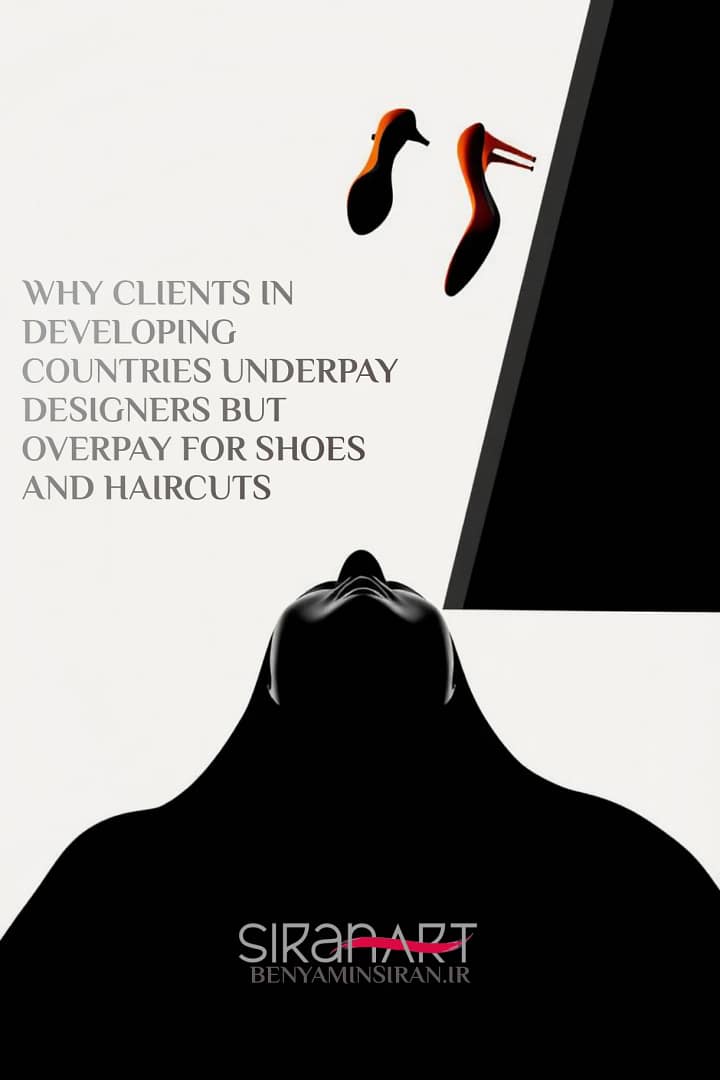Why Clients in Developing Countries Underpay Designers but Overpay for Shoes and Haircuts

There exists a curious paradox in the majority of developing countries: people will aggressively haggle or avoid paying good prices for creative services like graphic design, branding, or web development but are willing to spend money liberally on consumer goods like branded shoes or frequent visits to the hairdresser. Psychologically, this is no accident—it lies squarely in the way we view value, cultural conditioning, and how humans assign worth to tangible and intangible products.
Tangibility Bias: We Value What We Can Touch
Humans naturally place a higher value on tangible objects than on intangible labor.
The work of a designer—logos, websites, or branding strategies—lives almost exclusively in a digital format. It cannot be “held” or showcased in the same manner that sneakers or a leather bag can.
A shoe or a haircut gives immediate sensory feedback. You can show them off, touch them, and see them. The gratification is immediate, so the purchase feels more “real” and warranted.
Psychologically, tangibility is a factor in trust. Consumers in developing economies typically have little disposable income, and they prefer to invest in things that they can readily confirm instead of intangible promises.
The “Luxury Signaling” Effect
In cultures where economic disparities are apparent, social status signaling emerges as a key impetus for expenditures.
Designer services are invisible to your social circle—your friends won’t see the invoice that you paid for your company’s logo.
Designer shoes or a high-priced haircut are visible status symbols, immediately discerned and envied by one’s peers.
They are “positional goods” from a behavioral economics perspective—goods that gain value merely by enhancing the purchaser’s perceived social status.
The DIY Fallacy: “I Could Do That Myself”
Creative work is beset on all sides by the illusion of accessibility. People underestimate the skill, time, and expertise that professional design requires because:
- They’ve seen simplified online tools like Canva or Wix.
- They believe creativity is “natural talent” and not a highly acquired skill.
This creates the expectation that design needs to be cheap—after all, if it looks simple, then it must be simple to produce. Conversely, not many individuals think they can professionally cut their own hair or craft luxury sneakers by hand, so they don’t as readily question the cost.
Payment Culture and Negotiation Norms
Bargaining is a part of daily trade in most developing nations.
For services like design, where pricing isn’t standardized and costs can vary widely, clients assume they should negotiate down.
For branded consumer goods, prices seem “fixed,” so individuals accept them without complaint—particularly if the brand’s international reputation conveys that it’s worth it.
Instant Gratification vs. Delayed Gratification
A properly done brand identity or website can take weeks to months to fully realize value. It’s an investment—one that pays dividends in the long run.
Meanwhile, a haircut or pair of shoes delivers immediate satisfaction and dopamine release. This temporal discounting—the human tendency to value immediate rewards more than future ones—skews spending toward instant pleasures.
The Invisible ROI Problem
A designer’s job is return on investment (ROI)—improved branding equals improved customer trust, increased sales, and long-term growth.
However, ROI is abstract and often invisible to the client until much later.
Haircuts and footwear have direct, concrete effects and thus are psychologically simpler to justify, despite the fact that they yield no financial return.
Colonial and Cultural Value Conditioning
Post-colonial economies have inherited consumer cultures whereby foreign-branded goods are viewed as being more desirable than local creative labor. A Nike shoe carries an international brand status that a local designer—no matter how talented—cannot match in prestige.
This establishes a cultural hierarchy of worth: branded, imported, or physical goods at the top; local, service-oriented, or intangible goods at the bottom.
How Designers Can Address This Bias
1. Make the Invisible Visible
Show before-and-after changes and real business results from past projects.
2. Package Services Like Products
Provide definite, fixed-price packages with concrete deliverables to replicate the “product purchase” experience.
3. Educate on Value
Use storytelling and case studies to connect design work directly to client success.
4. Build Personal Brand Prestige
Just like luxury goods, a strong personal brand increases perceived value and price tolerance.
In Summary
Developing-world clients aren’t just being unreasonable when they underprice design—they’re reacting to fundamental psychological biases in favor of tangibility, status signaling, and immediate gratification. The task for creative professionals is to refocus the perception of design from a discretionary cost to a visible, high-status, and essential investment—more like those shoes or haircuts they don’t mind paying for.
